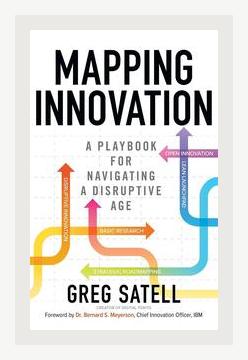Leadership and ManagementInnovation Leadership
Title: Mapping Innovation: A Playbook for Navigating a Disruptive Age
Author: Greg Satell
Category: Innovation Leadership
Overview and Structure:
“Mapping Innovation” by Greg Satell is a comprehensive guide that demystifies the process of innovation and provides a structured approach to managing it. The book is positioned as a ‘playbook’ for leaders in the rapidly changing terrain of the modern business world. Satell argues that innovation is not a one-size-fits-all endeavor but varies depending on specific contexts and challenges. His framework categorizes innovation into different types and offers strategic guidance for each.
1. Understanding Innovation:
Satell begins with the premise that innovation is not just about new ideas but about solving problems. He identifies that different types of problems require different innovative approaches.
Example:
– Satell cites the example of Jonas Salk and the development of the polio vaccine. Traditional approaches were not yielding results, so Salk adopted a new methodology—which required a blend of collaboration and experimentation.
Action:
– Identify the Problem Type: Assess whether your problem is a known issue with known solutions, or if it’s a novel problem needing new approaches. Map your innovation strategy accordingly.
2. The Four Types of Innovation:
Satell introduces a framework of four categories of innovation: Sustaining, Breakthrough, Disruptive, and Basic Research.
- Sustaining Innovation: Enhancing what exists.
- Example: Apple’s iterative improvements on the iPhone fall under sustaining innovation.
-
Action: Focus on incremental improvements to existing products or services.
-
Breakthrough Innovation: Creating new concepts.
- Example: The development of CRISPR technology for genetic editing.
-
Action: Invest in R&D labs or centers of excellence to pursue high-risk, high-reward innovations.
-
Disruptive Innovation: Making costly solutions accessible and affordable.
- Example: Netflix disrupted the traditional video rental market with its subscription-based streaming service.
-
Action: Look for opportunities to democratize high-end technology or services.
-
Basic Research: Pursuing knowledge for future application.
- Example: Government-funded research in various scientific fields that later fuel innovation.
- Action: Partner with academic institutions or invest in long-term research projects.
3. Innovation Ecosystems:
Satell stresses the importance of not operating in isolation but rather participating in broader innovation ecosystems consisting of companies, universities, startups, and government entities.
Example:
– The development of lithium-ion batteries involved collaboration across universities, private companies like Sony, and governmental funding bodies.
Action:
– Build Networks: Engage with external innovation partners, including academia, startups, and industry consortia.
4. Combating the Innovator’s Dilemma:
Highlighting Clayton Christensen’s work on ‘The Innovator’s Dilemma,’ Satell explains how successful companies can fail by being too focused on sustaining innovations and ignoring disruptive technologies.
Example:
– Kodak’s downfall for neglecting digital photography in favor of sustaining its film business.
Action:
– Anticipate Disruptions: Allocate resources to scout for and invest in emerging technologies and business models, even if they conflict with your existing products.
5. Scaling Innovation:
Innovations should be scalable to impact society at large. Satell suggests creating a reliable process for scaling and embedding innovations within the organization.
Example:
– Procter & Gamble’s “Connect + Develop” program, which opened its innovation process to external ideas and partnerships, ultimately leading to scalable product development.
Action:
– Implement Open Innovation Programs: Create systemic processes for incorporating external ideas and scaling successful innovations.
6. Learning from Failure:
Satell argues that failure is an essential component of the innovation process. He advocates for a culture that accepts and learns from failures.
Example:
– The story of Google X, Google’s moonshot factory, where failure is considered a necessary step toward groundbreaking innovations like self-driving cars.
Action:
– Promote a Fail-Fast Culture: Encourage fast iteration and learning cycles by supporting experiments and learning from unsuccessful attempts without blame.
7. Leadership for Innovation:
Effective leadership is crucial for fostering an innovative culture. Leaders should be able to inspire and guide their teams through the uncertainty that innovation brings.
Example:
– Elon Musk’s leadership style at Tesla and SpaceX, where he sets bold visions and challenges teams to achieve seemingly impossible goals.
Action:
– Cultivate Visionary Leadership: Develop leadership skills that involve setting visionary goals, encouraging risk-taking, and supporting teams in navigating uncertainties.
8. The Role of Technology in Innovation:
Technological advancements often drive significant innovations. However, technology should be seen as an enabler rather than the end goal.
Example:
– The internet’s role in transforming industries—from retail (Amazon) to transportation (Uber).
Action:
– Leverage Emerging Technologies: Assess how new technological developments can solve problems in novel ways and invest accordingly.
Conclusion:
“Mapping Innovation” by Greg Satell offers a nuanced perspective on the different facets of innovation. By recognizing the types of innovation and the need for a diversified approach, the book equips leaders to navigate the complexities of today’s business environment effectively. Practical examples and actionable strategies provided throughout the book act as a roadmap for achieving sustainable innovation success.
Key Actions for Leaders:
- Identify Problem Types and Match Innovation Strategy: Tailor your approach based on the nature of the problem—sustaining, breakthrough, disruptive, or basic research.
- Engage with Ecosystems: Actively participate in broader innovation networks to leverage diverse expertise and resources.
- Balance Sustaining and Disruptive Efforts: Ensure that resources are allocated towards both improving existing solutions and exploring disruptive innovations.
- Scalable Innovation Processes: Develop structured processes for scaling promising innovations.
- Learn from Failures: Foster an organizational culture that sees failure as a learning opportunity.
- Visionary Leadership: Encourage leadership that is bold, inspiring, and supportive of innovative efforts.
- Harness Technology: Use emerging technologies as tools to drive innovative solutions.
By applying these principles and actions, leaders can enhance their ability to drive meaningful innovation within their organizations and contribute to broader societal advancements.
